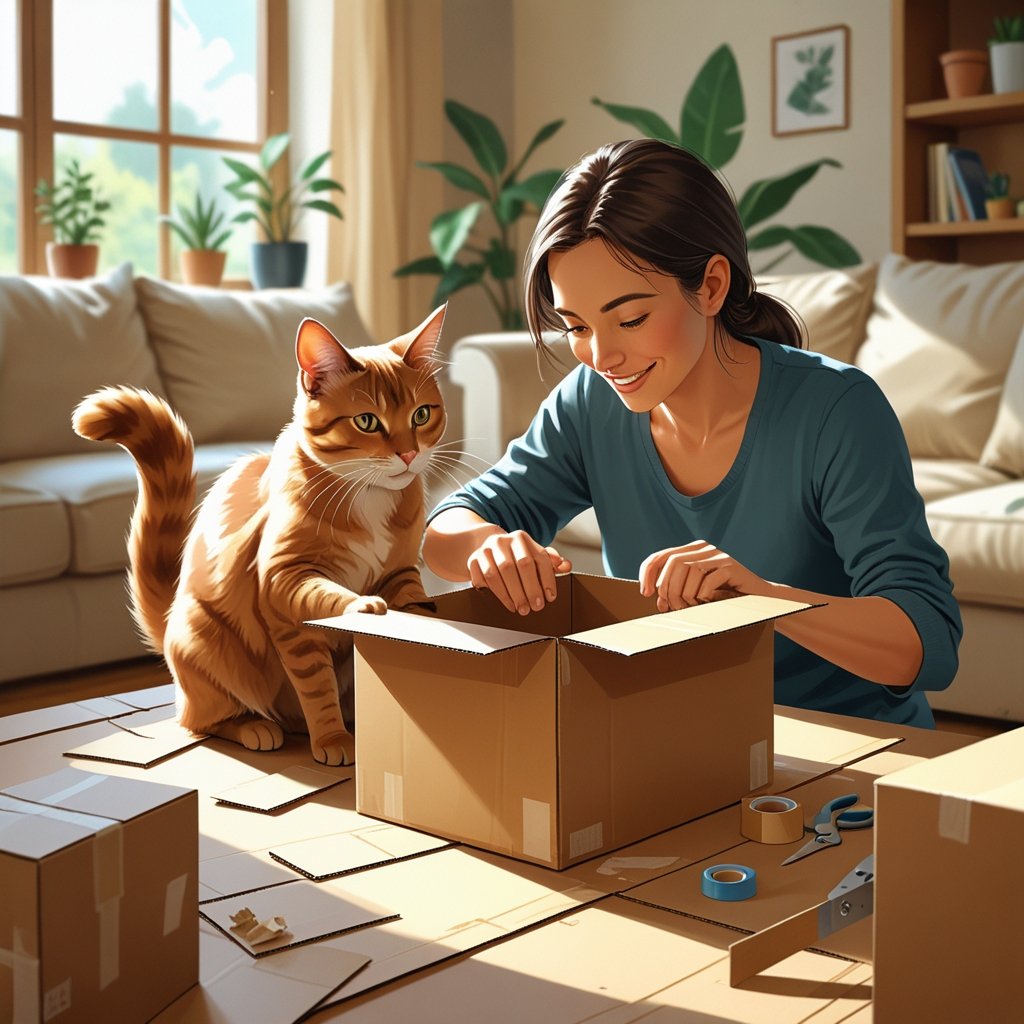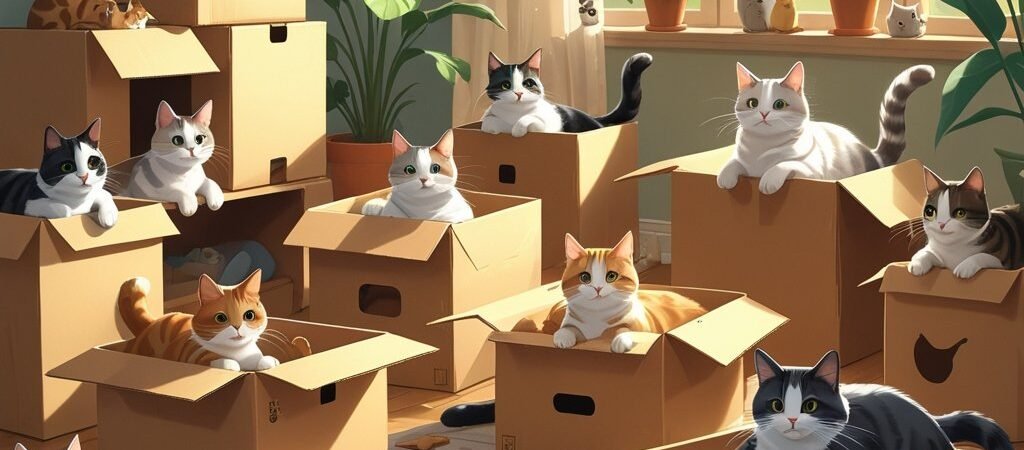Meta Description: Discover why cats are obsessed with boxes and learn how to use this behavior to enrich your cat’s life. Expert tips for DIY cat enrichment using simple cardboard boxes.
If you’ve ever brought home an expensive cat toy only to watch your feline friend ignore it completely in favor of the cardboard box it came in, you’re not alone. The internet is filled with photos and videos of cats choosing boxes over beds, toys, and even comfortable furniture. This seemingly quirky behavior isn’t just amusing – it’s deeply rooted in your cat’s natural instincts and psychology.
Understanding why cats are so irresistibly drawn to boxes can help you provide better enrichment for your feline friend while saving money on expensive toys. More importantly, you can use this knowledge to create a more stimulating and comfortable environment that satisfies your cat’s deepest behavioral needs.
Let’s explore the fascinating reasons behind cats’ box obsession and discover how you can harness this natural behavior to enhance your cat’s quality of life and mental wellbeing.
The Science Behind the Box Obsession: Understanding Feline Psychology
The love affair between cats and boxes isn’t just a cute quirk – it’s backed by solid behavioral science and evolutionary psychology.
Security and Safety: The Ultimate Safe Space
From a cat’s perspective, a box represents the perfect hiding spot. In the wild, cats are both predators and prey, which means they’ve evolved to seek out enclosed spaces that offer protection from potential threats while providing a good vantage point for hunting.

A box satisfies this deep-seated need for security by providing walls on multiple sides, eliminating the possibility of surprise attacks from those directions. Your cat can monitor their environment from the safety of their box fortress while feeling completely secure that nothing can sneak up on them from behind or from the sides.
This behavior is so fundamental that even the most pampered indoor cats retain this instinctual drive for secure hiding places. The box becomes their personal safe room where they can relax, observe, and feel completely in control of their environment.
Stress Reduction and Comfort
Research has shown that hiding places, including boxes, can significantly reduce stress levels in cats. A study conducted with shelter cats found that cats provided with hiding boxes adapted to their new environment faster and showed fewer signs of stress compared to cats without hiding spaces.
When cats feel stressed or overwhelmed, they naturally seek out small, enclosed spaces where they can decompress. Boxes provide immediate stress relief by giving cats a sense of control over their environment and reducing the amount of stimuli they need to process.
Temperature Regulation: The Perfect Insulator
Cardboard boxes offer excellent insulation properties that help cats maintain their preferred body temperature. Cats typically prefer temperatures between 86-97°F (30-36°C), which is significantly warmer than most human-comfortable room temperatures.
The cardboard material traps warm air and provides insulation from cool floors and drafts. When a cat curls up inside a box, their body heat is contained and reflected back to them, creating a cozy microclimate that’s just right for comfortable rest and relaxation.
This temperature regulation aspect explains why cats often seem even more drawn to boxes during cooler weather or in air-conditioned homes.
The Psychology of Confinement: Why Tight Spaces Feel Good
Cats have a unique relationship with confined spaces that might seem counterintuitive to humans who often prefer open, spacious environments.
The “If I Fits, I Sits” Phenomenon

You’ve probably seen the meme “If I fits, I sits,” which perfectly captures cats’ tendency to squeeze into spaces that seem impossibly small for their size. This behavior stems from their natural flexibility and their psychological comfort with snug spaces.
Tight-fitting boxes provide what behaviorists call “thigmotaxis” – the comfort derived from physical contact with surfaces. When a cat is surrounded by the walls of a box, they experience a calming sensation similar to being gently held or hugged.
Predator Instincts and Ambush Points
Boxes also appeal to cats’ hunting instincts by providing the perfect ambush point. From inside a box, a cat can observe potential prey (or playmates) while remaining hidden. This gives them a tactical advantage and satisfies their natural predatory behaviors even in a domestic setting.
Many cat owners have experienced the surprise pounce from a cat hiding in a box – this is your cat practicing their hunting skills and having fun with their natural instincts.
Control and Territory
Cats are territorial animals who like to control their environment. A box becomes an instant territory that belongs exclusively to them. Unlike shared spaces in your home, the box is unambiguously theirs, giving them a sense of ownership and control that’s psychologically satisfying.
Different Types of Boxes and Their Appeals
Not all boxes are created equal in the eyes of your cat. Understanding what makes certain boxes more appealing can help you provide better enrichment options.
Size Preferences
Just-Right Boxes: Cats typically prefer boxes that are just large enough for them to fit comfortably while still feeling snug. A box that’s too large doesn’t provide the same sense of security, while one that’s too small may be uncomfortable.
Multiple Size Options: Providing boxes of various sizes allows your cat to choose based on their mood and needs – sometimes they want a cozy hideaway, other times they might prefer a slightly roomier space for stretching.
Material Matters
Cardboard Quality: Sturdy cardboard boxes hold up better to cat use and provide better structural integrity for climbing and scratching. Flimsy boxes may collapse and could discourage use.
Texture Considerations: Some cats prefer smooth cardboard, while others enjoy corrugated textures they can scratch. Pay attention to your cat’s preferences and provide variety.
Shape and Design Features
Open-Top vs. Enclosed: While classic open-top boxes are popular, some cats prefer boxes with small entrance holes that make them feel even more secure.
Multiple Openings: Boxes with two openings (entrance and escape route) can be less stressful for some cats who don’t like feeling trapped.
Creative Box Enrichment Ideas for Your Cat
Now that you understand why cats love boxes, here are practical ways to use this knowledge to enrich your cat’s environment.
DIY Box Modifications

Create Viewing Windows: Cut small holes in the sides of boxes to create peepholes. This allows your cat to observe their surroundings while maintaining the security of their hideout.
Multi-Level Box Condos: Stack and connect boxes to create complex structures. Cut holes between levels to create tunnels and multiple rooms. This provides vertical territory and satisfies climbing instincts.
Scratching Integration: Leave some boxes unmodified for scratching. Many cats enjoy clawing at cardboard, which helps maintain their claws and marks territory.
Comfort Additions: Place soft blankets or towels inside boxes to make them even more appealing for napping. The combination of security and comfort creates an irresistible resting spot.
Box Rotation Strategy
Fresh Box Schedule: Regularly introduce new boxes to maintain interest. Even if your cat has a favorite box, occasionally providing a fresh one keeps the enrichment novel and exciting.
Seasonal Considerations: During colder months, focus on smaller, well-insulated boxes. In warmer weather, larger boxes with better ventilation might be more appealing.
Location Variety: Place boxes in different areas of your home – sunny spots for warmth, quiet corners for privacy, and elevated locations for security and observation.
Interactive Box Games
Treasure Hunt Boxes: Hide treats or small toys inside boxes to encourage exploration and foraging behaviors.
Puzzle Box Feeders: Cut holes in box sides and place food puzzles inside. This combines the security of the box with the mental stimulation of puzzle feeding.
Catnip Enhancement: Sprinkle a small amount of catnip inside boxes to make them even more enticing. This works especially well when introducing a new box.

Box Safety Considerations
While boxes provide excellent enrichment, it’s important to ensure they’re safe for your cat’s use.
Hazardous Materials to Avoid
Toxic Inks and Chemicals: Avoid boxes with heavy printing, especially those with glossy finishes or strong chemical odors. Plain cardboard is always safest.
Staples and Sharp Objects: Remove all staples, sharp tape edges, and any metal or plastic attachments that could injure your cat.
Size Safety: Ensure boxes are large enough that your cat won’t get stuck, but not so large that they could fall and injure themselves if the box is elevated.


Regular Inspection and Replacement
Wear and Tear Monitoring: Replace boxes when they become too worn, torn, or unstable. Damaged boxes can collapse unexpectedly and potentially injure your cat.
Cleanliness Maintenance: While cats don’t typically soil boxes used for hiding, monitor for any hygiene issues and replace boxes as needed.
Understanding Individual Preferences
Every cat is unique, and their box preferences can vary significantly based on personality, age, and past experiences.
Personality-Based Preferences
Confident Cats: Bold, outgoing cats might prefer boxes with multiple openings or elevated positions where they can survey their domain.
Shy or Anxious Cats: More timid cats often gravitate toward smaller, more enclosed boxes in quiet, low-traffic areas.
Playful Cats: Active cats might enjoy boxes they can pounce on, tunnel through, or use as launching pads for play.
Age-Related Considerations
Kittens: Young cats often prefer smaller boxes and enjoy boxes they can play in with siblings or toys.
Adult Cats: Mature cats typically have established preferences and may be particular about box size, location, and privacy level.
Senior Cats: Older cats might need boxes with lower sides for easy entry and exit, and prefer locations that don’t require jumping or climbing.
Beyond Boxes: Extending the Principle
Understanding why cats love boxes can help you provide other forms of enrichment that satisfy the same psychological needs.
Alternative Hiding Spots
Cat Tunnels: Fabric or paper tunnels provide similar security benefits with the added appeal of being able to move through them.
Under-Furniture Spaces: Ensure your cat has access to safe under-furniture hiding spots that mimic the box experience.
Cat Caves and Igloos: Commercial cat beds designed as enclosed spaces can satisfy the same needs as boxes while providing more permanent solutions.
Environmental Modifications
Vertical Spaces: Cat trees with enclosed cubbies combine the appeal of boxes with climbing opportunities.
Quiet Zones: Designate quiet areas of your home where your cat can retreat when they need space, even without boxes.
Frequently Asked Questions About Cats and Boxes
Q: How often should I replace my cat’s boxes?
A: Replace boxes when they become worn, damaged, or start to smell. Most boxes last 2-4 weeks with regular use, depending on your cat’s activity level and the box quality.
Q: My cat ignores expensive beds but loves cheap boxes. Is this normal?
A: Absolutely! This is incredibly common and completely normal. Boxes satisfy specific psychological needs that expensive beds might not address, regardless of their comfort level.
Q: Can multiple cats share boxes?
A: Some cats will share larger boxes, but many prefer their own space. If you have multiple cats, provide several boxes to prevent competition and ensure each cat has access to their own secure space.
Q: Why does my cat prefer certain boxes over others?
A: Cats may have preferences based on size, location, material, or even scent. Pay attention to which boxes your cat uses most and try to identify the common features to guide future box selection.
Conclusion: Embracing Your Cat’s Box Love
Understanding why cats love boxes reveals important insights into feline psychology and natural behavior. This simple preference for cardboard containers reflects deep-seated needs for security, comfort, territory, and stress reduction that are fundamental to your cat’s wellbeing.
By embracing your cat’s love of boxes and using this knowledge strategically, you can provide rich, satisfying enrichment that costs virtually nothing but delivers tremendous value for your cat’s mental and emotional health. Rather than fighting this quirky behavior, celebrate it as an easy way to make your cat happier and more comfortable in their environment.
The next time you receive a package, before you recycle that cardboard box, consider offering it to your cat first. You might be surprised at how much joy and comfort such a simple gift can provide. After all, the best cat enrichment often comes not from expensive gadgets, but from understanding and working with your cat’s natural instincts and preferences.
Remember, a happy cat is one whose natural behaviors are understood and accommodated. Boxes provide an easy, affordable way to honor your cat’s instincts while strengthening your bond through thoughtful environmental enrichment.
What creative ways have you used boxes to enrich your cat’s environment? Share your DIY box ideas in the comments below!
Ready to create the ultimate cat-friendly environment? Check out our recommendations for cat-safe cardboard options, complementary enrichment toys, and comfort accessories that work perfectly with your cat’s natural box-loving behavior.
Related Articles You Might Enjoy:
- “Funniest Cat Behaviors Explained”
- “Top 10 Friendliest Cat Breeds for Families”
- “The Maine Coon: Giant Gentle Cats Everyone Loves”
- “Understanding Cat Body Language: What Your Cat Is Really Telling You”
Keywords: cats love boxes, cat enrichment, DIY cat toys, cat behavior, cardboard boxes for cats, cat hiding spots, feline psychology, cat stress reduction, cat territory, box safety for cats

